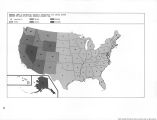| OCR Text |
Show By a series of acts in 1866, 1870, and 1877,2 when Federal policy stressed the disposition of the public domain under the homestead, public sale, and other settlement and disposal laws, Congress provided that such Federal land disposals would not carry with them an accompanying water right. Rather, the water on the public lands was declared open to use, and property rights to its use were to be obtained under the laws and customs of the states and territories. As to lands retained in Federal ownership, there were none of the public land management programs we know today requiring water use on Federal lands by the Federal Government or its agents, e.g., mineral leasing operations, recreation facility management, fish and wildlife protection and habitat enhancement, and so forth. Accordingly, the Federal Government did not then have to face up to whether it would comply with state water laws. By the turn of the century, the Federal Government had started reserving public lands from disposition by setting aside national forests and parks, creating wildlife refuges, and making large-scale withdrawals for other purposes. With respect to the water needs associated with programs on these lands, the usual practice during the first half of this century was for permittees, licensees, etc., to acquire necessary water rights under state law in accordance with the policy stated in the 1866, 1870, and 1877 acts. The Federal agencies generally followed that same practice for their program needs. In the 11 western states the predominant water right system is the law of prior appropriation, which was adopted as being most suitable to a water-short region. Under this system prior use establishes priority of right, and nonuse for prescribed periods will cause a forfeiture. In times of shortage, uses are curtailed in inverse order of their priorities. The riparian law of water rights 3 which prevailed in the more humid eastern states was rejected as unsuitable. Its principal vice was that an upstream riparian owner could do nothing indefinitely while his neighbor downstream put water to use and became dependent thereon, yet at any time the upper riparian could assert his equal right and destroy or impair the effort and investment of his neighbor. An appropriative water right may be acquired only for a beneficial purpose, and even if the proposed type of use is beneficial under state law, it must 2 The revelant portions of the acts are codified as 43 U.S.C. §§321,661 (1964). 3 The riparian system has three major features, all of which are the antithesis of the appropriation doctrine. First water may be used only by a riparian landowner, on riparian land, and within the natural drainage basin of the stream from which it is taken. Second, it is neither acquired by use nor lost by nonuse. Third, it is correlative, in that all users share shortages ratably. 142 usually also be a reasonable use in the light of other demands for water. While there are diversities among the water laws of these states, they are generally consistent in recognizing, by statute or decision, domestic and municipal purposes, irrigation, mining, power, and manufacturing, as well as other similar uses, as beneficial. Although the decided court cases indicate that there is no serious problem in obtaining rights for recreation and fish and wildlife conservation, several of these states do not expressly specify such uses as beneficial in their water statutes. Nearly all state appropriative water laws also establish a system of preferences under which certain beneficial uses are preferred over others. In most of these 11 states, domestic, stock-watering, and municipal uses appear to have preferred status over irrigation, and irrigation is preferred over all the remaining uses. Recreation and fish and wildlife uses are not preferred uses in these states. This has caused concern that Federal program needs, particularly for fish and wildlife, may not be fully served if the Federal Government must rely on these state laws. However, while problems for Federal agencies may yet develop because of state laws relating to beneficial use or preferences, none has been brought to our attention. In nearly 100 years of development, state water law has achieved a reasonable certainty of results which has permitted substantial public and private development in the West. While sometimes necessarily complex, state administrative and judicial procedures have provided a means to determine security of rights to the use of water. However, in 1955, the Supreme Court in the Pelton Dam decision 4 indicated that the withdrawal or reservation of Federal lands for specified purposes also reserved rights to use water on such lands, even though the legislative or executive action made no mention of water or its use. Under this doctrine such reserved water rights would carry a priority as of the date of the reservation or withdrawal of the lands. Although the possible consequences of the decision that state law need not control the acquisition of water rights for such "reserved" lands were disturbing to many in the western public land states, under the facts of the case the Pelton Dam decision itself did not require infringement of water rights previously vested under state law. The limits and impact of the newly enunciated application of the reservation doctrine were left uncertain. However, some of the Federal agencies began to rely on this doctrine for water rights in addition to their customary compliance with state law. 4 Federal Power Commission v. Oregon, 349 U. S. 435(1955). |







































































































































































































































































































































































